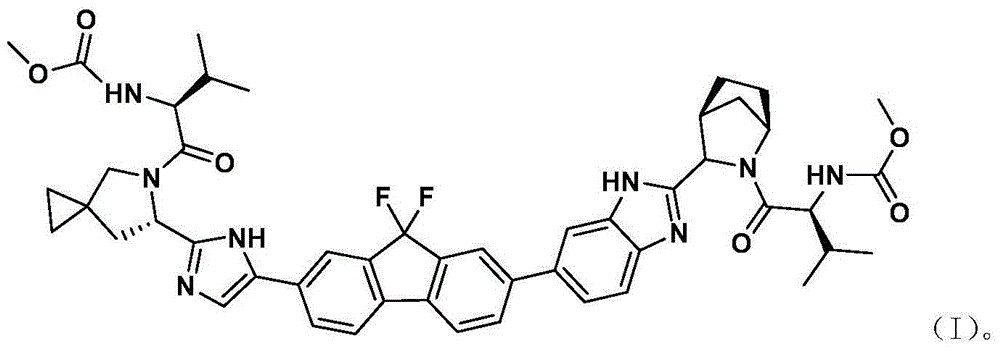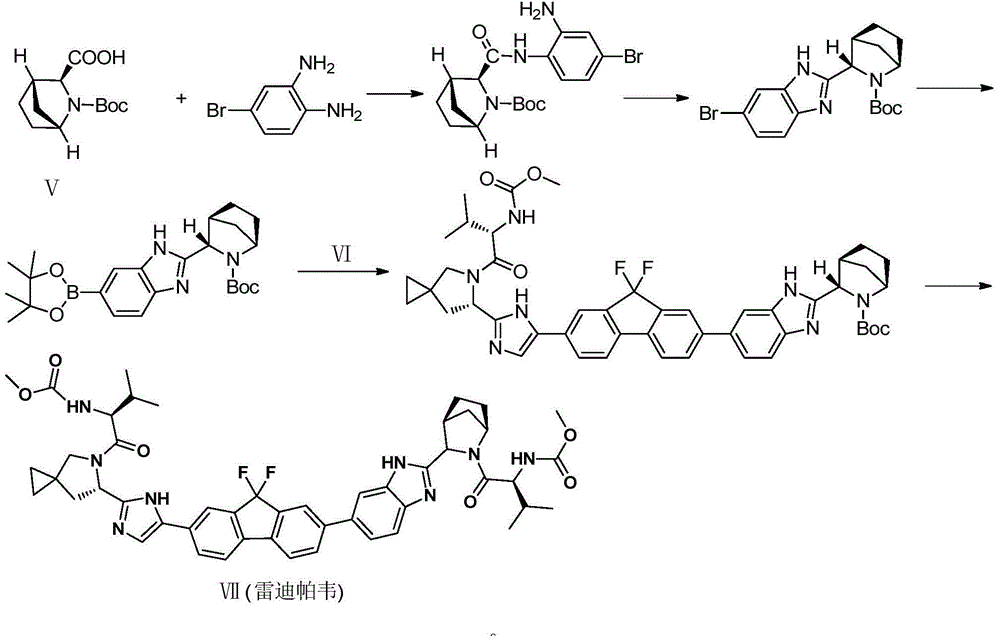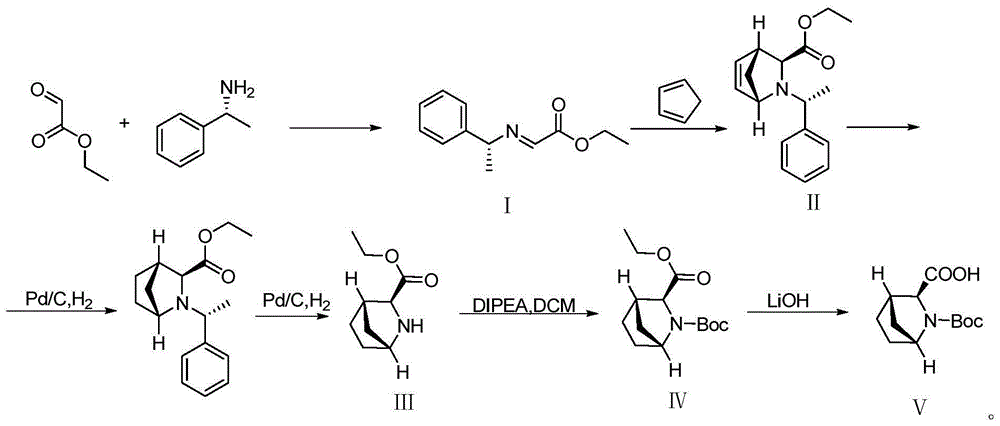Ledipasvir intermediate preparation method
A unit time, azabicyclic technology, applied in the direction of organic chemistry, can solve the problems of long production cycle, inability to reflect atom economy, cumbersome post-processing, etc., achieve shortened production cycle, high yield, and reduce the use of solvents Effect
- Summary
- Abstract
- Description
- Claims
- Application Information
AI Technical Summary
Problems solved by technology
Method used
Image
Examples
Embodiment 1
[0034] Example 1 Preparation of (1R, 3S, 4S)-N-tert-butoxycarbonyl-2-azabicyclo[2,2,1]heptane-3-carboxylic acid
[0035] Under the condition of -10°C to 0°C, (R)-phenethylamine (47.5g) was slowly added dropwise to ethyl glyoxylate (80g), Molecular sieves (30g) in toluene (80g), dropwise, react at -10°C to 0°C for 3 hours, add methanol (63.3g), then slowly drop trimethylchlorosilane (85.02g), dropwise, -10 ℃ to 0 ℃ for 2 hours, and then slowly added dropwise the newly prepared cyclopentadiene (50.0g), dropwise, -10 ℃ to 0 ℃ for 3 hours, then added 10% palladium carbon (5.3g), to the reaction Put hydrogen gas into the bottle, react at room temperature about 27°C for 3 hours, then add sodium hydroxide solution (0.8mL, 2mol / L), dropwise, react at room temperature for 2 hours, then lower the reaction system to -5°C to 0°C, Add Boc anhydride (102g), after the addition is complete, react at -10°C to 0°C for 4 hours. After the reaction is complete, remove the filter residue by filtra...
Embodiment 2
[0036] Example 2 Preparation of (1R, 3S, 4S)-N-tert-butoxycarbonyl-2-azabicyclo[2,2,1]heptane-3-carboxylic acid
[0037] -10°C to 0°C, (R)-phenethylamine (47.5g) was slowly added dropwise into dichloromethane (80g) containing methyl glyoxylate (80g), anhydrous sodium sulfate (40g) After dropping, react at -10°C to 0°C for 3 hours, add methanol (63.3g), then slowly add trimethylchlorosilane (85.02g), dropwise, react at -10°C to 0°C for 2 hours, then slowly Add freshly prepared cyclopentadiene (50.0g) dropwise, and react at -10°C to 0°C for 3 hours, then add 5% palladium carbon (10.6g), and pass hydrogen gas into the reaction bottle, and the room temperature is about 27°C React at low temperature for 3 hours, then add sodium hydroxide solution (0.8L, 2mol / L), dropwise, react at room temperature for 2 hours, reduce the reaction system to -5°C to 0°C, add Boc anhydride (102g), and add, React at -10°C to 0°C for 4 hours. After the reaction is complete, remove the filter residue by...
Embodiment 3
[0038] Example 3 Preparation of (1R, 3S, 4S)-N-tert-butoxycarbonyl-2-azabicyclo[2,2,1]heptane-3-carboxylic acid
[0039] Under the condition of -10°C to 0°C, (R)-phenethylamine (47.5g) was slowly added dropwise to ethyl glyoxylate (80g), anhydrous sodium sulfate (40g) in toluene (80g), dropwise After completion, react at -10°C to 0°C for 3 hours, add methanol (63.3g), then slowly drop trimethylchlorosilane (85.02g), dropwise, and react at -10°C to 0°C for 2 hours, then slowly drop Freshly prepared cyclopentadiene (50.0g), dropwise, react at -10°C to 0°C for 3 hours, then add 5% palladium carbon (10.6g), feed hydrogen into the reaction bottle, and react at room temperature at about 27°C After 3 hours, potassium hydroxide solution (0.8L, 2mol / L) was added, and the dropwise reaction was completed at room temperature for 2 hours. React at ℃ to 0℃ for 4 hours. After the reaction is completed, remove the filter residue by filtration. Add 2mol / L hydrochloric acid solution to the fil...
PUM
 Login to View More
Login to View More Abstract
Description
Claims
Application Information
 Login to View More
Login to View More - R&D
- Intellectual Property
- Life Sciences
- Materials
- Tech Scout
- Unparalleled Data Quality
- Higher Quality Content
- 60% Fewer Hallucinations
Browse by: Latest US Patents, China's latest patents, Technical Efficacy Thesaurus, Application Domain, Technology Topic, Popular Technical Reports.
© 2025 PatSnap. All rights reserved.Legal|Privacy policy|Modern Slavery Act Transparency Statement|Sitemap|About US| Contact US: help@patsnap.com



